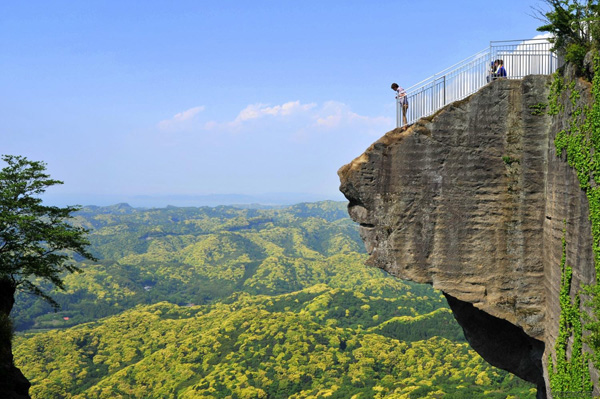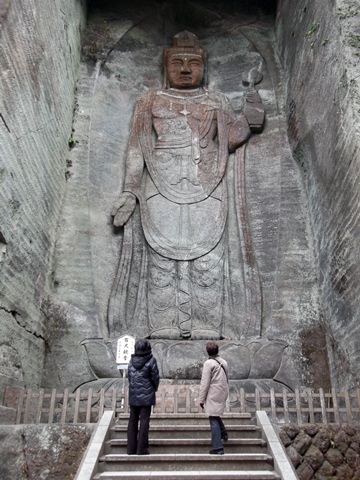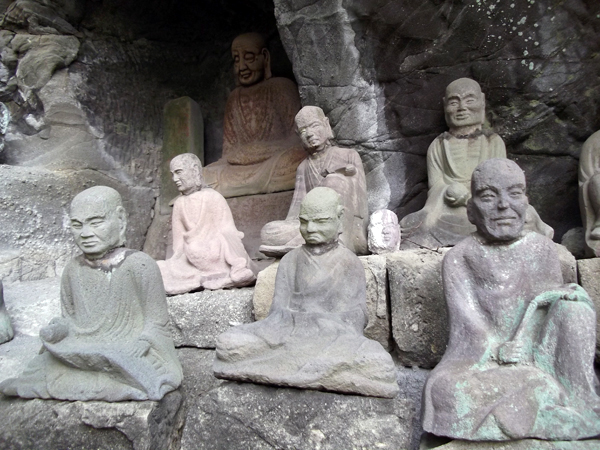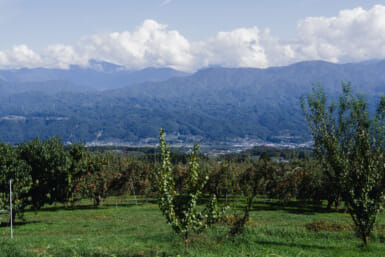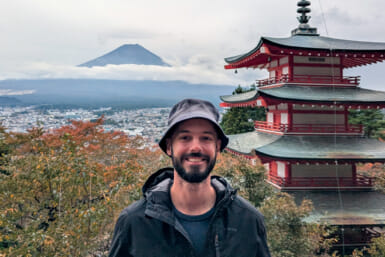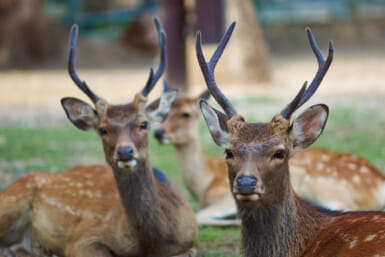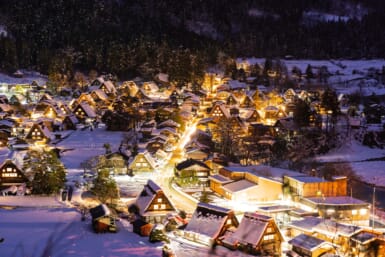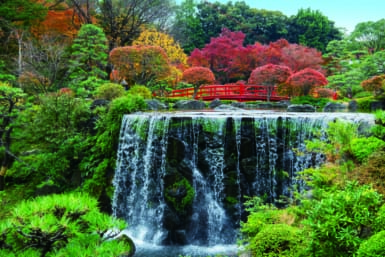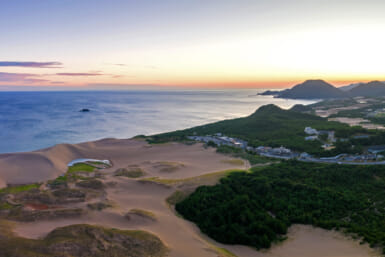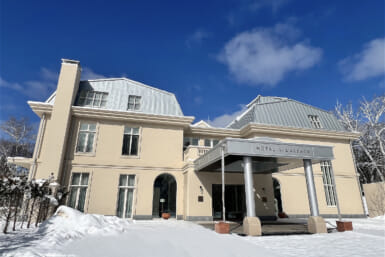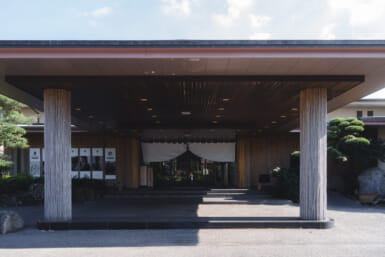Nokogiriyama – the “saw-tooth mountain – in Chiba, is one of the best day-trips from Tokyo but for some reason its great hiking and wonderful views are lesser known than those of its counterparts to the west of town… It’s just a short trip over the Tokyo Bay Aqua-Line or a train ride away – so what’s stopping you?
by Peter Sidell
Nokogiriyama – Chiba’s Hidden Gem
Go to the top of any of the tall buildings in Tokyo and you might get the impression that the urban labyrinth never ends, so uninterrupted is the greyness spreading towards the horizons.
Head east into Chiba prefecture, however, and it’s possible to not only get out into lush green countryside and fresh air, but also to take in an important piece of Japan’s spiritual past.
Overlooking the town of Kanaya on the coast of Tokyo Bay, Nokogiriyama isn’t a staid, dreary museum piece; with mountaintop lookouts and its sprawling temple grounds and gardens, it’s a place where venerable Buddhist statues live in harmony with their appealing natural setting.
If you’re feeling energetic it’s possible to scale the 329m (1,080ft) mountain on foot from Kanaya in about an hour (the trail starts about 15 minutes from the ferry port, or ten minutes from Hamakanaya JR station) but you can save your legs for the paths at the top by driving or taking the cable car that whisks you to near the summit in just a few minutes.
The Cable Car
Arriving at the cable car station you’ll find lookouts that give a sweeping 360-degree panorama: on one side you have a fine view across Tokyo Bay to the Miura Peninsula and, on a very clear day, to the Izu Peninsula and Mount Fuji beyond, while on the other you can see the rough-hewn coastline and the scenic, rumpled landscape of low hills inland.
From there, a short walk along a rough path and down some sheltered steps brings you to Nihon-ji temple, founded in 725, and it’s here that you’ll find the main Nokogiriyama must-see sights.
Did you know?
The Daibutsu represents Yakushi Nyorai, the Buddha of Healing; he took three years to carve, between 1780 and 1783.
Owing to weathering and earthquake damage, the Daibutsu needed extensive restoration and that was completed in 1966. The Hyakushaku Kannon was carved at the same time as this restoration work and was completed in 1963.
Hyaku means 100; shaku is a traditional unit of measurement based on the average length between nodes on bamboo, defined as being 10/33m, or 30.3cm. Although its use was discontinued by law in 1966, it’s still used informally in such fields as traditional carpentry.
An Arhat is a Buddhist disciple who has achieved nirvana, or complete spiritual enlightenment; the 1500 Arhat statues were carved between 1779 and 1798.
Nokogiriyama means ‘Saw-tooth mountain’ and its name pertains to its jagged, zigzag profile. This comes from its days as a quarry, when it was used as a source of stone to lay foundations in the marshy land on which Edo was built.
The period of the area’s history as a quarry (from the 14th to the 18th century) is evident from the straight lines and flat, chiseled rock faces, and from the precise angles of the alcove inhabited by the Hyaku-shaku Kannon, a relief image of the Buddhist Goddess of Mercy carved into the rock.
At over 30m high she towers over visitors, bestowing mercy on supplicants with a slight frown that suggests she’d rather be out in the open air than stuck in her box.
Despite her constriction and the lack of light due to high walls around, though, she’s an impressive piece of work and appears dignified and austere.
A few minutes on from the Kannon is the Ruriko observatory, a collection of lookout points providing more views out across Tokyo Bay, and also of the forested hills stretching north towards Tokyo.
A View of Hell
One of the lookouts here is known as Jigoku Nozoki, ‘A view of hell’, after the vertiginous drop it overlooks from its precarious-looking outcrop above the Kannon; I’m sure it’s perfectly safe, but I wouldn’t like to be there during an earthquake.
From here you can take the ‘1500-Arhat Approach’ down the Nokogiriyama mountain. This long path winds left and right and up and down past shelves, caves and alcoves in the rock, some naturally formed, some man-made, and each clustered with carved statues of Buddhist devotees and deities.
There are only in fact 538 now, as many of those originally placed here were destroyed in a nationwide wave of anti-Buddhist violence, prompted by the government’s establishment of Shinto as the state religion and the outlawing of Buddhist practice at the start of the Meiji Period in 1868; however, those that survived are still numerous enough to display a tremendous variety of expressions, with as wide a range as humans in their postures, faces and manners.
They’re standing, sitting and occasionally reclining, smiling, frowning, sometimes scowling, each in a rather un-saintly fashion. Some of them chat convivially with their neighbours, some of them perch in hermit-like solitude. Many are badly weathered or cracked, or lack limbs or heads – beheading was a common method of Meiji-era violation – but those that have made it through the ages intact display the exquisite craftsmanship, lavish attention to detail and imagination of their makers.
This is also a very atmospheric part of Nokogiriyama; while the very top is rather bare in places, along these paths it seems nature is determinedly encroaching to reclaim its territory.
There are steps and stones completely overgrown with vivid green moss and ferns growing out of the cracks, roots push their way up out of the earthen paths and a fallen tree across one of the flights of steps has been there long enough for ivy to have completely overgrown and enveloped its base.
Down a slope you come to the stately Daibutsu, sitting meditatively on his pedestal in a tranquil clearing; he’s around the same height as the Kannon and as elegantly simple a piece of work, but the setting gives him a more peaceful air than his companion up the hill.
The Stone Buddha at Nokogiriyama
At 31m he’s the largest stone-carved Buddha figure in Japan, with a deeply serene expression and posture that acts in harmony with the natural surroundings to create a restful atmosphere, making this the best place on the mountain to pause for a break, some reflection and perhaps a picnic lunch.
If you want to approach the mountain as originally intended then the main entrance to Nihon-ji is actually along the coast between Hamakanaya and Hota stations. The narrow path takes you slowly uphill through an airy forest of tall, slender trees until you come to two ancient stone lanterns that stand like sentinels on either side.
The vermilion buildings at the entrance make a striking contrast with the lush greenery around, and beyond them there’s a compact garden with cherry blossom trees overlooking a pond spanned by stone bridges that look as old as anything else here.
Just a couple of hours south of the big city, Nokogiriyama makes for a day out that’s both refreshing and interesting, leaving you to head back to the urban jungle with a clear mind and lifted spirits.
Access: Hamakanaya and Hota stations are on the JR Uchibo line; it’s also possible to reach Kanaya by the Tokyo Bay ferry from Kurihama if you’re coming from south west of Tokyo, or along Route 127 down the coast if you’re driving. The Tokyo Bay Aqua-Line, too, offers a ‘shortcut’ with a view.

